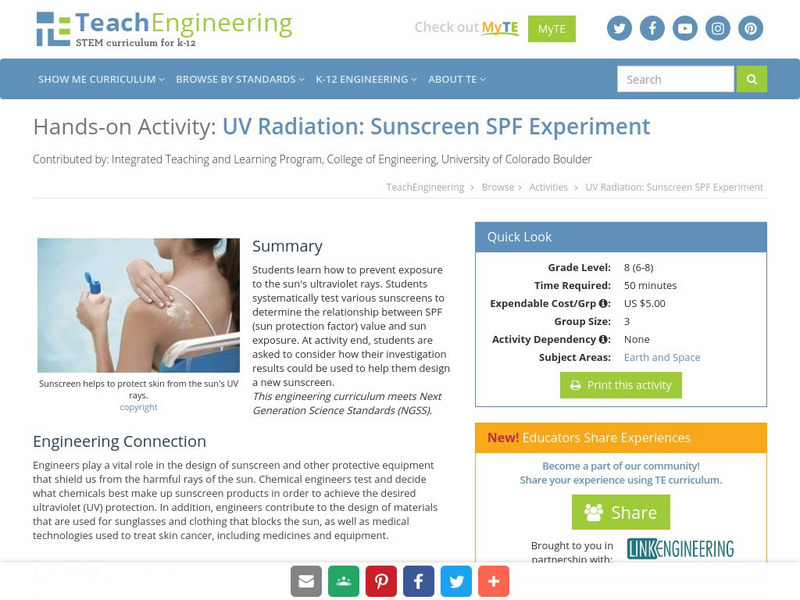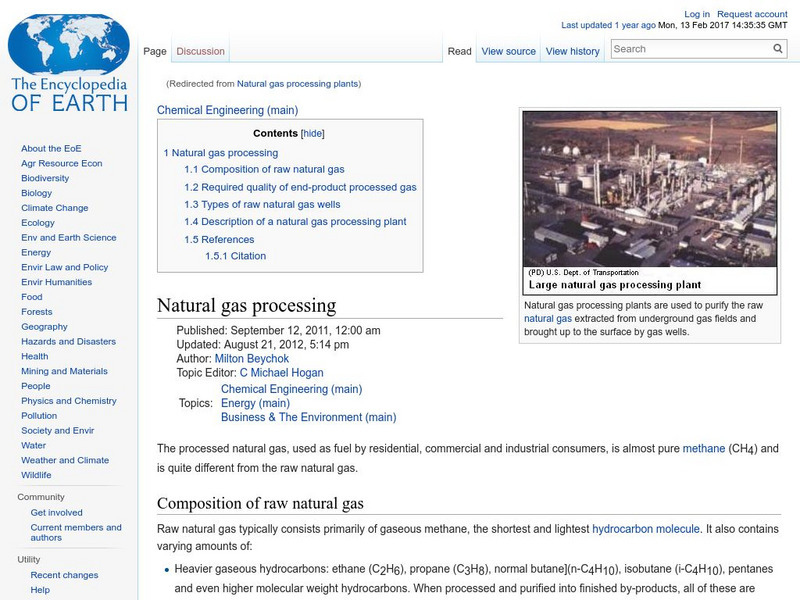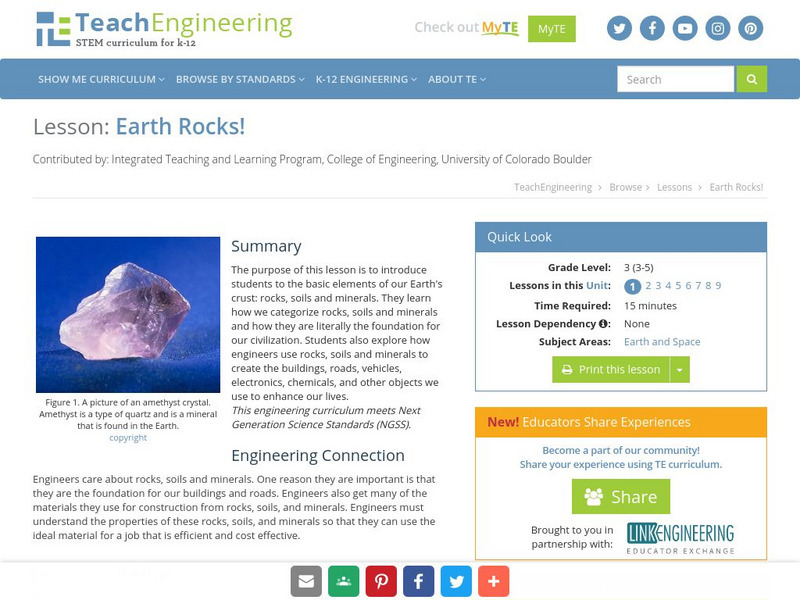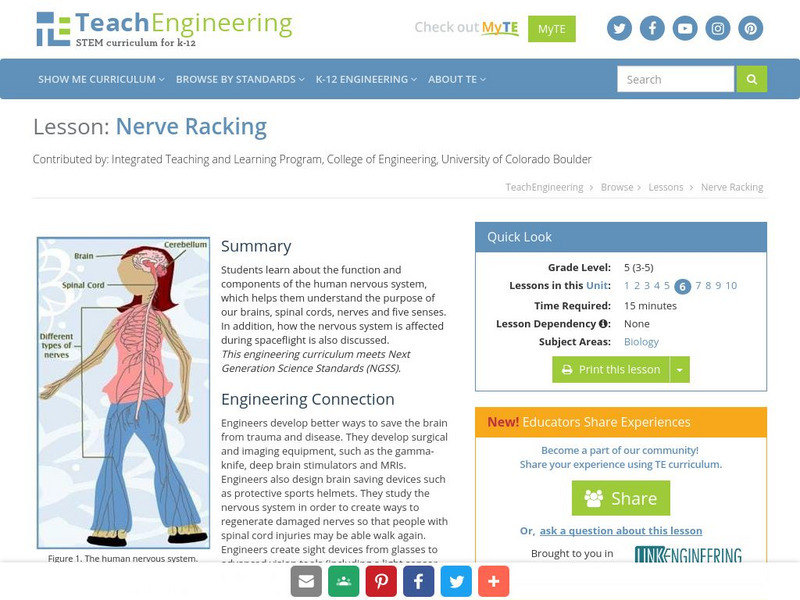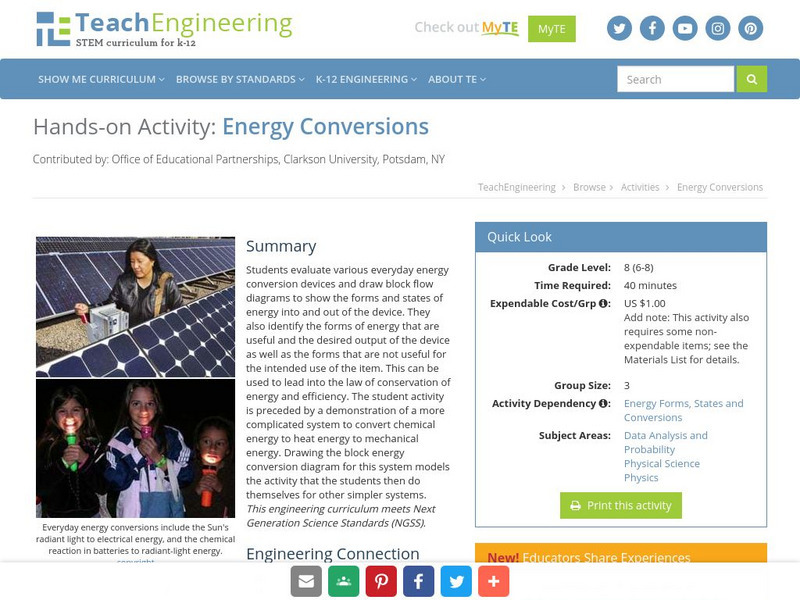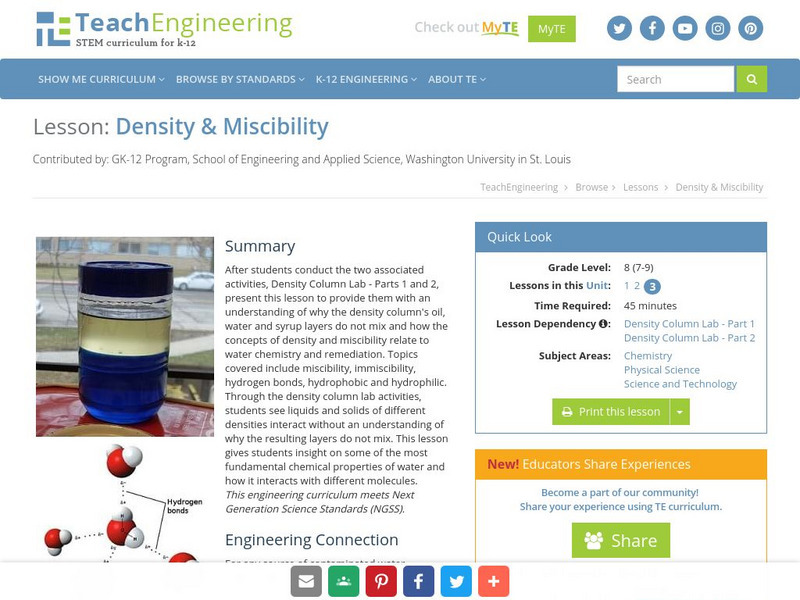Hi, what do you want to do?
Cosmo Learning
Cosmo Learning: Chemical Reaction Engineering
A collection of video lectures from a chemical reaction engineering course taught at the National Programme on Technology Enhanced Learning. In thirty-nine lectures, the course covers topics including chemical reactions, thermodynamics,...
TeachEngineering
Teach Engineering: Cereal Magnets
In this activity, students will design a process that removes the most iron from the cereal. This activity is meant for the students to experiment with different materials using what they know about iron, magnets, and forces to design...
TeachEngineering
Teach Engineering: A Tasty Experiment
Students conduct an experiment to determine whether or not the sense of smell is important to being able to recognize foods by taste. They do this by attempting to identify several different foods that have similar textures. For some of...
TeachEngineering
Teach Engineering: It Burns!
In this activity, students learn how to prevent exposure to the Sun's harmful ultraviolet rays. Students will systematically test various sunscreens to determine the relationship between spf (sun protection factor) value and sun...
TeachEngineering
Teach Engineering: Eat Iron?!!
To gain an understanding of mixtures and the concept of separation of mixtures, students use strong magnets to find the element of iron in iron-fortified breakfast cereal flakes. Through this activity, they see how the iron component of...
TeachEngineering
Teach Engineering: Surface Tension
Surface tension accounts for many of the interesting properties we associate with water. By learning about surface tension and adhesive forces, students learn why liquid jets of water break into droplets rather than staying in a...
Encyclopedia of Earth
Encyclopedia of Earth: Chemical Engineering: Natural Gas Processing
Explains the composition of natural gas and what is required to make it market-ready, types of reservoirs, and what happens in a natural gas processing plant. Includes a diagram showing the whole process. (Published: September 12, 2011)
BiologyWise
Biology Wise: Types of Genetic Engineering
Describes three types of genetic engineering - analytical genetic engineering, applied genetic engineering, and chemical genetic engineering.
Other
Gmfn: u.s. Chemical Giant Monsanto Wields Control
This article has lots of information on the practices of Monsanto, the chemical giant that produces Roundup and Roundup Ready Grains.
TeachEngineering
Teach Engineering: Rock Solid
Rocks cover the earth's surface, including what is below or near human-made structures. With rocks everywhere, breaking rocks can be hazardous and potentially disastrous to people. Students are introduced to three types of material...
TeachEngineering
Teach Engineering: Earth Rocks!
The purpose of this lesson is to introduce young scholars to the basic elements of our Earth's crust: rocks, soils and minerals. They learn how we categorize rocks, soils and minerals and how they are literally the foundation for our...
TeachEngineering
Teach Engineering: The Earth Is a Changin'
This lesson introduces and describes the main types of erosion (i.e., chemical, water, wind, glacier and temperature). Students learn examples of each type of erosion and discuss how erosion changes the surface of the Earth. Students...
TeachEngineering
Teach Engineering: Aqua Thrusters!
In this activity, students construct their own rocket-powered boat called an "aqua-thruster." These aqua-thrusters will be made from a film canister and will use carbon dioxide gas - produced from a chemical reaction between an antacid...
TeachEngineering
Teach Engineering: Nerve Racking
This lesson describes the function and components of the human nervous system. It helps students understand the purpose of our brain, spinal cord, nerves and the five senses. How the nervous system is affected during spaceflight is also...
TeachEngineering
Teach Engineering: Bridging to Polymers: Thermoset Lab
Students act as engineers to learn about the strengths of various epoxy-amine mixtures, and observe the unique characteristics of different mixtures of epoxies and hardeners. Student groups make and optimize thermosets by combining two...
TeachEngineering
Teach Engineering: Spectroscopy
Students learn how using a spectrograph helps us understand the composition of light sources. Using simple materials and holographic diffraction gratings (available online at a variety of sites, including Edmund Scientifics and the...
TeachEngineering
Teach Engineering: Photosynthesis Life's Primary Energy Source
This lesson covers the process of photosynthesis and the related plant cell functions of transpiration and cellular respiration. Students will learn how engineers can use the natural process of photosynthesis as an exemplary model of a...
TeachEngineering
Teach Engineering: Energy Conversions
Students evaluate various everyday energy conversion devices and draw block flow diagrams to show the forms and states of energy into and out of the device. They also identify the forms of energy that are useful and the desired output of...
TeachEngineering
Teach Engineering: Wizardry and Chemistry
Students learn how common pop culture references (Harry Potter books) can relate to chemistry. While making and demonstrating their own low-intensity sparklers (muggle-versions of magic wands), students learn and come to appreciate the...
TeachEngineering
Teach Engineering: Things That Matter to Flocculants
Prior to reaching households, water is exposed to a variety of treatments designed to render it fit for human consumption and use. One of the first treatment steps is the removal of suspended solids using chemical additives called...
TeachEngineering
Teach Engineering: Density & Miscibility
After students conduct the two associated activities, Density Column Lab - Parts 1 and 2, present this lesson to provide them with an understanding of why the density column's oil, water and syrup layers do not mix and how the concepts...
TeachEngineering
Teach Engineering: Digital Mapping and Geographic Information Systems (Gis)
Geographic information systems (GIS), once used predominantly by experts in cartography and computer programming, have become pervasive in everyday business and consumer use. This unit explores GIS in general as a technology about which...
TeachEngineering
Teach Engineering: Solid, Liquid or Gas?
Students are given a variety of materials and asked to identify if each material as a solid, liquid or gas. They use their five senses - sight, sound, smell, texture and taste - to identify the other characteristics of each item.
American Chemical Society
American Chemical Society: Chemical & Engineering News: Reel Science
Reel Science publishes reviews of movies with a science or science fiction theme. Its aim is to heighten awareness of inaccuracies in the ways science is presented in film, and to promote greater public understanding of true science.








